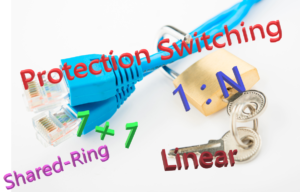What is the Extra Traffic Signal for APS (Automatic Protection Switching) Purposes?
ITU-T G.808 Defines the Extra Traffic Signal as:
A Traffic signal is carried over the protection transport entity and/or bandwidth when that transport entity/bandwidth is not being used to protect a normal traffic signal, i.e., when the protection transport entity is on standby.
Whenever the protection transport entity/bandwidth is required to protect or restore the normal traffic on the working transport entity, we will preempt the extra traffic.
Extra traffic is not protected.
What Does All That Mean?
1:1 and 1:n protection switching schemes often support two types of signals.
- The Normal Traffic Signal and
- The Extra Traffic Signal
The Normal Traffic signal is the high-priority traffic signal that we designed our protection switching scheme to protect.
A Normal Traffic signal will usually travel through a Protection Group (from one Network Element to another) via the Working Transport entity.
What if the Network Declares a Service-Affecting or Signal Degrade Defect Condition with the Working Transport Entity?
However, suppose the Network detects a service-affecting or signal degrade defect within the Working Transport entity. In that case, the protection group will route the corresponding Normal Traffic Signal through the Protection Transport entity.
The Extra Traffic signal is a lower-priority (and therefore, pre-emptible) traffic signal that will travel through a Protection Group (from one Network Element to another) via the Protection Transport entity whenever it is in standby mode.
In other words, as long as the one (or n) Normal Traffic signals can travel on their Working Transport entities (e.g., the normal condition), then the Extra Traffic signal will use the Protection Transport entity.
The Extra Traffic Gets Dropped
However, suppose the Tail-End circuitry (within the Protection Group) declares a defect condition and asserts the SF or SD indicators. In that case, the protection scheme will respond to this event by entirely dropping the Extra Traffic signal and routing the Normal Traffic Signal through the Protection-Transport entity in its place.
In some cases, the system operator will transmit the NULL signal, or the ODU-OCI Maintenance signal, via the Protection Transport entity, instead of the Extra-Traffic Signal.
However, unlike the NULL Signal or the ODU-OCI Maintenance signal, the Extra Traffic Signal can transport user (or client) traffic. The end customers need to know that their traffic is a lower priority and that Protection-Switching events can preempt (or wipe out) their traffic/service.
In some cases, the Network Service Provider can offer their customers service via an Extra Traffic Signal for a reduced price because this traffic is low priority and preemptible.
Figure 1 presents a drawing of a 1:2 Protection Switching system.
This figure shows the Normal Traffic signals traveling on the two Working Transport entities. Normal Traffic Signal # 1 travels along W1 (the Working Transport Entity # 1). Further, Normal Traffic Signal # 2 travels along W2 (the Working Transport Entity # 2).
Additionally, this figure shows the Extra Traffic Signal traveling through the Protect Transport entity (P).

Figure 1, Drawing of a 1:2 Protection Switching system, with the Extra Traffic Signal highlighted.
How Protection-Switching Preempts the Extra Traffic Signal
If the Network declares a service-affecting defect within one of the Working Transport entities, all the following events will occur.
- The affected Normal Traffic Signal will now use the Protect Transport entity instead, and
- The Protection-Switching Network will drop (or preempt) the Extra Traffic Signal.
Figure 2 shows a drawing of the 1:2 Protection Group during protection switching.
In this case, the Network declared a defect within the Working Transport entity associated with Normal Traffic Signal # 1.
Consequently, Normal Traffic Signal # 1 is now using the Protect Transport entity, and the Protection Group is now pre-empting the Extra Traffic signal.

Figure 2, Drawing of a 1:2 Protection Switching system when a Protection Switch preempts the Extra Traffic signal.
NOTE: The Extra Traffic signal cannot be a high-priority signal for the following reasons.
- We do not protect this signal. If a Service-Affecting defect occurs and we, in turn, lose the Extra-Traffic Signal, our Protection-Switching system will do nothing about it.
- Even worse, the Extra-Traffic signal is also expendable should one of the Normal Traffic signals need to use the Protect Transport entity.
Has Inflation got You Down? Our Price Discounts Can Help You Beat Inflation and Become an Expert on OTN and Protection-Switching!! Click on the Banner Below to Learn More!!
Discounts Available for a Short Time!!
Click on the Image Below to see more Protection-Switching related content on this Blog:



